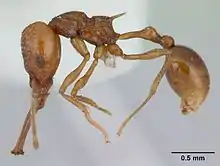Acanthognathus
Acanthognathus is a genus of ants that are found in tropical Central and South America.[2] There are 7 living species and 1 extinct species, Acanthognathus poinari, known only from fossil records.[3]
| Acanthognathus | |
|---|---|
 | |
| Acanthognathus teledectus worker | |
| Scientific classification | |
| Domain: | Eukaryota |
| Kingdom: | Animalia |
| Phylum: | Arthropoda |
| Class: | Insecta |
| Order: | Hymenoptera |
| Family: | Formicidae |
| Subfamily: | Myrmicinae |
| Tribe: | Attini |
| Genus: | Acanthognathus Mayr, 1887[1] |
| Type species | |
| Acanthognathus ocellatus Mayr, 1887 | |
Description
They are reddish in colour and have long trap-jaws that can be compared to those of Odontomachus. These predatory ants live in small colonies that typically consist of less than 30 adults.[2]
Acanthognathus has large, line-shaped jaws, each with an apical fork of 3 spiniform teeth that interlock when fully closed; Preapical dentition sometimes present but often absent. Jaws open to 170 degrees or more. Basal process of mandible a long curved spur that is minutely bifurcated apically; when the mandibles are fully closed, the basal processes intersect and are ventral to the labrum and at the apex of the labio-maxillary complex; when fully open the mandibles are held in that position by opposition of the basal processes alone. Trigger hairs arise from mandibles (one of each); trigger hairs lie flat against margin when jaws close, becoming erect when the jaws are open.
Taxonomy
The genus was established by Mayr (1887) to house the species A. ocellatus, described from a single worker found in Brazil.[4]
Mistakenly, the name Acanthognathus was re-used by German ichthyologist G. Duncker in 1912 for a genus of syngnathid fish,[5] but that is invalid as it is a junior homonym.[6] These are now placed in either Dunckerocampus or Doryrhamphus, as the former sometimes is considered a subgenus of the latter.[7][8] To further confuse, a genus of nemesiid spiders, Acanthogonatus, is frequently misspelled Acanthognathus.
List of species
| Scientific name[3] | Authority | Picture |
|---|---|---|
| Acanthognathus brevicornis | M. R. Smith, 1944 |  |
| Acanthognathus laevigatus | Galvis & Fernández, 2009[4] | |
| Acanthognathus lentus | Mann, 1922 |  |
| Acanthognathus ocellatus | Mayr, 1887 |  |
| †Acanthognathus poinari | Baroni Urbani & De Andrade, 1994[9] | |
| Acanthognathus rudis | Brown & Kempf, 1969 |  |
| Acanthognathus stipulosus | Brown & Kempf, 1969 | |
| Acanthognathus teledectus | Brown & Kempf, 1969 |  |
References
- Mayr, G. (1887). Südamerikanische Formiciden. Verhandlungen der Zoologisch-Botanischen Gesellschaft in Wien 37: 511-632.
- Brown, W. L., Jr., & W. W. Kempf (1969). A Revision of the Neotropical Dacetine Ant Genus Acanthognathus (Hymenoptera: Formicidae. Psyche 76(2): 87-109.
- Bolton, B. (2014). "Acanthognathus". AntCat. Retrieved 20 July 2014.
- Galvis, J. P.; Fernández, F. (2009). "Ants of Colombia X. Acanthognathus with the description of a new species (Hymenoptera: Formicidae)". Revista Colombiana de Entomología. 35: 245–249.
- Duncker, G. (1912). Die Gattungen der Syngnathidae. Mitteilungen Naturhist. Museum Hamburg 29: 219-240.
- Ride, W.D.L, H.G. Cogger, C. Dupuis, O. Kraus, A. Minelli, F. C. Thompson & P.K. Tubbs, eds. (1999). International Code of Zoological Nomenclature. 4th edition. International Trust for Zoological Nomenclature. ISBN 0-85301-006-4
- Whitley, G. P. (1933). Studies in ichthyology. No. 7. Records of the Australian Museum v. 19 (1): 60-112, Pls. 11-15.
- Dawson, C. E. (1985). Indo-Pacific pipefishes (Red Sea to the Americas). Gulf Coast Research Lab., Ocean Springs, Mississippi. Indo-Pacific pipefishes (Red Sea to the Americas). i-vi + 1-230.
- Baroni Urbani, C., & De Andrade, M. L. (1994). First description of fossil Dacetini ants with a critical analysis of the current classification of the tribe (Amber Collection Stuttgart: Hymenoptera, Formicidae. VI: Dacetini). Stuttg. Beitr. Naturkd. Ser. B ((page 12-15, Strumigenys senior synonym of Quadristruma).
External links
 Data related to Acanthognathus at Wikispecies
Data related to Acanthognathus at Wikispecies Media related to Acanthognathus at Wikimedia Commons
Media related to Acanthognathus at Wikimedia Commons